How many shots are in the average movie?
Last week, I experienced the latest Transformers movie. The constant fast-paced action and frenetic editing got me thinking just how many shots were in that movie.
Sadly, I lost count during the screening but afterwards, I resolved to look into the broader question: How many shots are in the average movie?
How many shots are in the average movie?
Let's start by directly answering the question which started this research. Across all the movies I could find data for (released 1997 to 2016), the average number of shots in a movie is 1,045. But I'm sure regular readers know that I'm not going to end the article purely because I've answered the original question!
Unsurprisingly, there are huge variations between movies. Russian Ark somewhat skews the average, seeing as it's a 99-minute movie told in one continuous shot, whereas Doomsday held the record for the most shots in the dataset, at 4,052.
If we break the results down by genre, we can see that documentaries have the lowest number of shots (an average of 491 shots), followed by music-based movies (814) and romantic films (869). At the other end of the spectrum, action films have the highest number of shots (1,913), followed by sci-fi (1,701) and adventure (1,681).
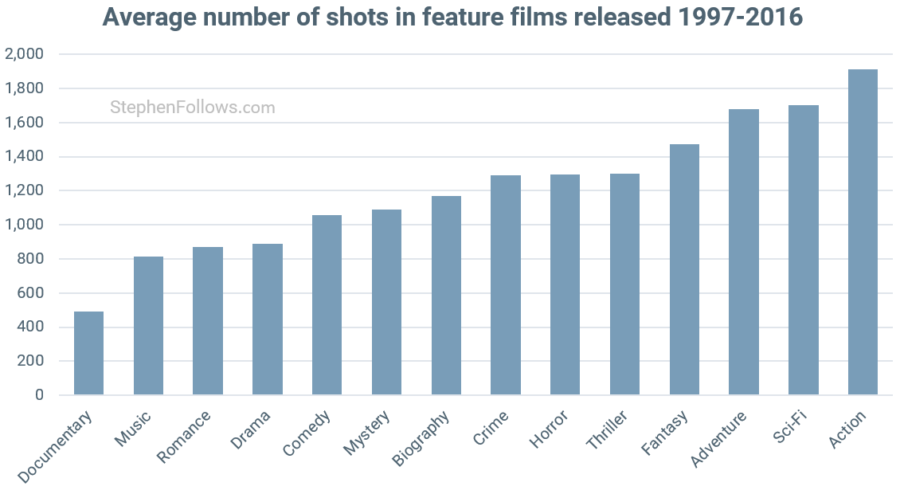
By now, you may have started to wonder what the correlation is with running time. Documentaries are often shorter than action films and this would affect the total number of shots. So let's change our metric and look at the length of the average shot in seconds.
(If you want to read more about the running time of movies then you may enjoy my article from last year entitled Are movies getting longer?).
How long is the average shot in a movie?
With this metric, we see the same cohort at the 'fast-paced' end - action films have an average shot length of 4 seconds, followed by adventure (5.1 seconds) and sci-fi (6.2 seconds).
At the slow-paced end, we now see that horror films have the fewest cuts, with an average shot length of 15.7 seconds (almost four times longer than action movies!)
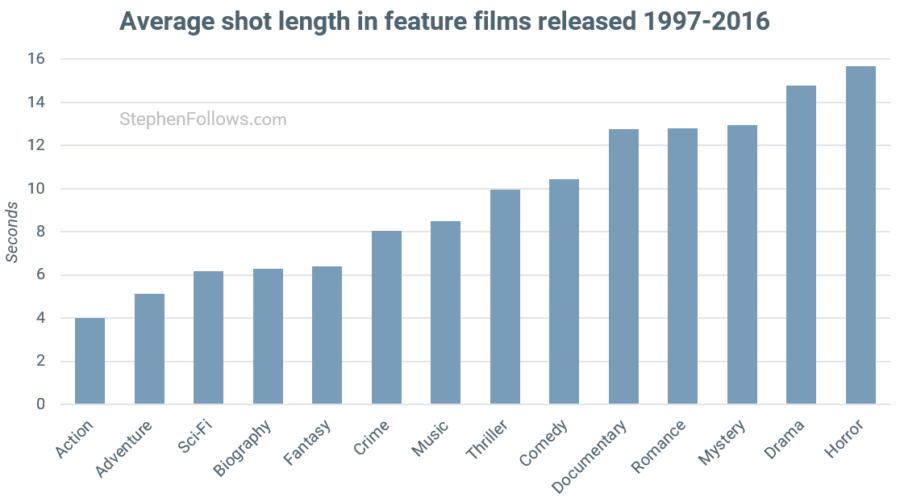
I'd love to be able to see how this changes over time, but sadly there isn't data on enough movies to draw conclusions. However, we can look at particular film series and see how they have evolved over time. Both the Iron Man and Bourne series saw a significant reduction in the length of the average shot over the course of their first three movies.
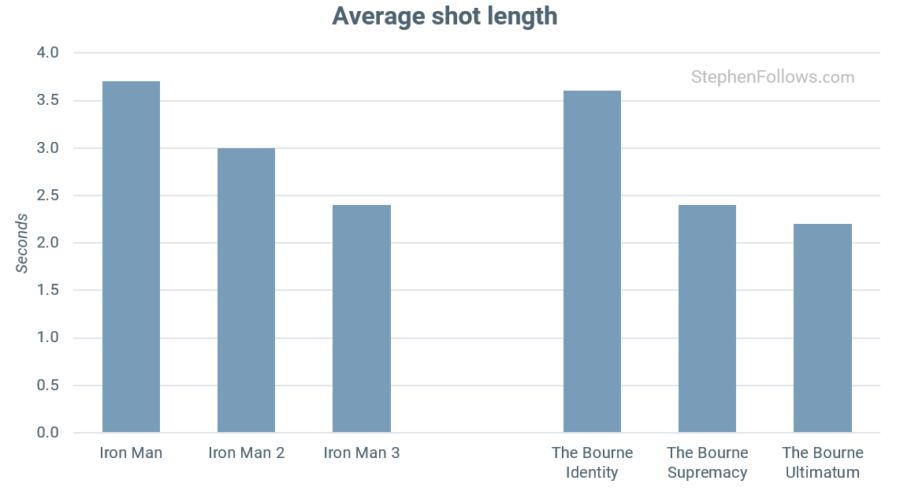
Some directors frequently cut
One of the ways we can measure the vast differences between the styles of different directors is to look at how they edit their movies (or, more correctly in most cases, how they instruct their editor to cut their movies).
The chart below compares the average shot length for selected directors from the dataset. The director with the shortest average short length is Paul W.S. Anderson (he of the Resident Evil series), with an average of just 2.4 seconds. On the other end of the spectrum is Michael Haneke whose average is a whopping 26.4 seconds (his movie Code Inconnu has just 191 shots through its two-hour running time).
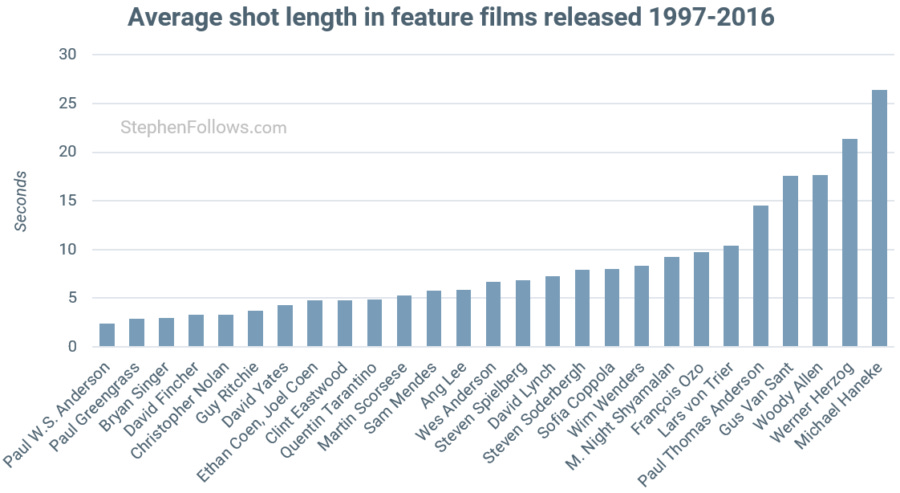
Whatever Transforms
To end this piece, let's compare two movies which came out in cinemas only a few days apart - Woody Allen's Whatever Works (starring Larry David) and Michael Bay's Transformers: Revenge of the Fallen (starring a truck which is also a robot).
Whatever Works
Total number of shots = 318
Average shot length = 16.5 seconds
Shortest shot = 1.1 seconds
Longest shot = 175.1 seconds
Transformers: Revenge of the Fallen
Total number of shots = 2,503
Average shot length = 3.4 seconds
Shortest shot = 0.2 seconds
Longest shot = 35.8 seconds
The chart below shows the length of the shots in each movie, expressed as a percentage of all shots (i.e. 15% of all shots in Transformers 2 were between 1 and 1.5. seconds long).
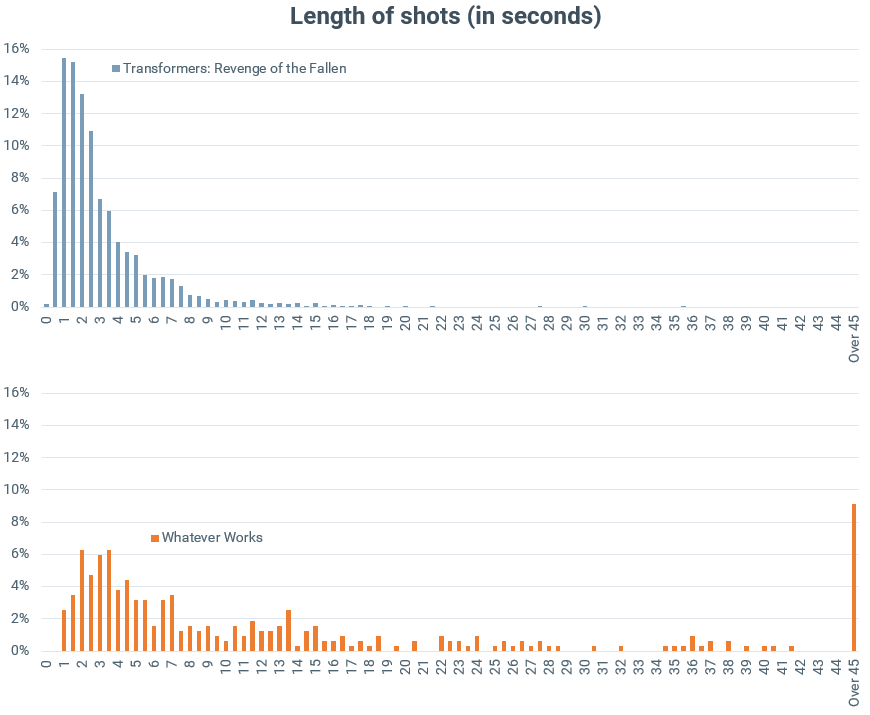
Notes
The raw data for today's research came via the crowd-sourced Cinemetrics database. I found and cleaned the relevant data (i.e. some movies were surveyed a few times so I looked into which seemed the most accurate), I added metadata and analysed the new dataset. I'm very grateful to the guys who built and manage the site, and to the 1,037 individual submitters who added data which ended up in my final research.
A special shout out should go to the submitters who surveyed a large number of movies. The following people all surveyed at least 20 of the movies I researched today: Adrian Tomas Samit, Cid Vasconcelos, Erik, Mohsen Nasrin, Eric T. Jones, Radomir D. Kokes, Barry Salt and Stew Fyfe.
This topic is always a bit of an inexact science. Measuring the exact number of shots can be tricky, it's prone to user error, there is no second step verification of submitted data and we don't have information on the vast majority of movies made. Nonetheless, I feel that we have enough data to discuss the overall trends shown above.
Epilogue
Today's topic was sparked by watching the new Transformers movie. My taste in movies is pretty broad and so certainly includes an interest in the crash-bang-wallop school of filmmaking. I can see why some cinephiles treat the movies of Michael Bay et al with disgust but I think they're missing a rich tapestry of cinematic spectacle.
To help, here are a few tips when watching a film of the ilk of Transformers 5: The Last Knight:
See it in IMAX or don't bother.
Think of it as a fireworks show, not a piece of narrative art.
Whatever ridiculous leap of logic the filmmakers are asking you to buy - go with it.
Know that it's ok to enjoy it, so long as you provide withering critique to your cinephile friends afterwards.
With those tips in mind, here is some pretty Bayhem...
https://www.youtube.com/watch?v=2THVvshvq0Q


